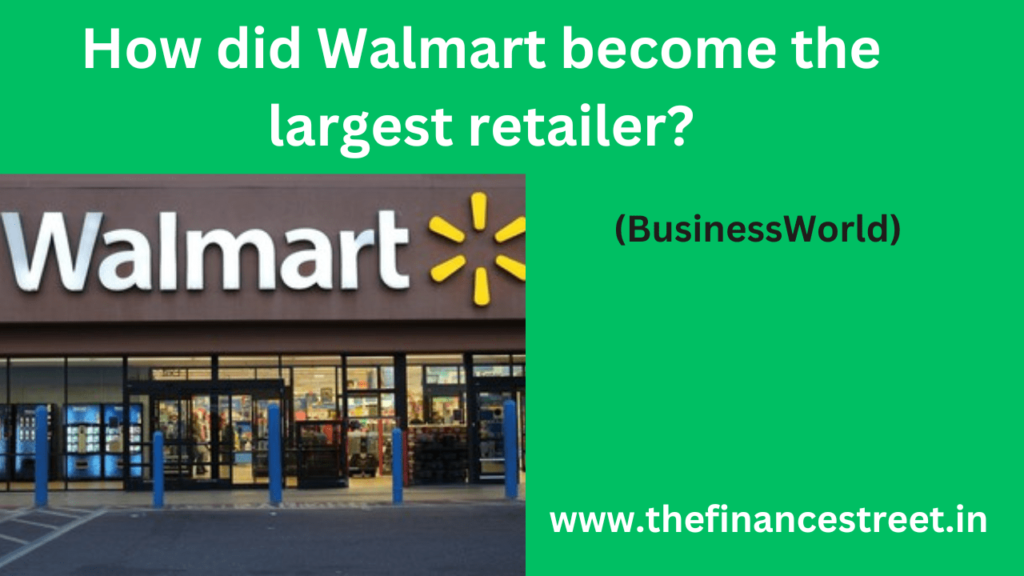Table of Contents
ToggleIntroduction-
Walmart’s business model stands as a testament to the power of scale, efficiency, and customer-centricity in the retail industry. With its humble beginnings as a small discount store in Arkansas, Walmart has grown into the world’s largest retailer, operating thousands of stores worldwide. At the core of its business model lies a relentless focus on providing everyday low prices, a vast product assortment, and convenient shopping experiences for millions of customers. By leveraging economies of scale, sophisticated supply chain management, and innovative technologies, Walmart has revolutionized the retail landscape and become a dominant force in the global market.
Central to Walmart’s business model is its commitment to offering low prices on a wide range of products, from groceries and household essentials to electronics and apparel. Through strategic sourcing, bulk purchasing, and efficient distribution, Walmart is able to negotiate favorable terms with suppliers and pass on cost savings to customers. This everyday low price strategy has not only earned Walmart a loyal customer base but has also disrupted traditional retail models, setting new standards for affordability and value in the industry.
Moreover, Walmart’s business model extends beyond its physical stores, encompassing e-commerce platforms, digital initiatives, and innovative services aimed at enhancing the customer experience. With a relentless focus on innovation and adaptation, Walmart continues to evolve its business model to meet the changing needs and preferences of consumers in an increasingly competitive and dynamic retail landscape.
How did Walmart become the largest retailer?
Walmart’s journey to becoming the largest retailer in the world is a result of several strategic decisions and operational innovations:
- Aggressive Expansion: Walmart prioritized rapid expansion, opening new stores at a remarkable pace. This aggressive growth strategy allowed Walmart to penetrate markets across the United States and later expand internationally, reaching customers in multiple countries.
- Everyday Low Prices (EDLP): Walmart’s EDLP strategy, pioneered by founder Sam Walton, focused on offering consistently low prices to customers. By leveraging economies of scale and efficient supply chain management, Walmart was able to keep prices low while maintaining profitability, attracting budget-conscious consumers.
- Efficient Supply Chain Management: Walmart revolutionized retail logistics with its advanced supply chain management systems. The company implemented innovative practices such as cross-docking, just-in-time inventory, and automated distribution centers to minimize costs, reduce inventory holding times, and streamline the flow of goods from suppliers to stores.
- Technology Adoption: Walmart embraced technology early on, investing heavily in information systems, data analytics, and inventory management technologies. The implementation of advanced point-of-sale systems, barcode scanning, and real-time inventory tracking improved operational efficiency, reduced stockouts, and enhanced customer service.
- Wide Product Selection: Walmart’s vast product selection, ranging from groceries and household goods to electronics and apparel, catered to diverse customer needs. By offering one-stop shopping convenience, Walmart became a destination for customers seeking a wide range of products at competitive prices.
- Customer-Centric Approach: Walmart prioritized customer satisfaction and convenience, focusing on providing a pleasant shopping experience and responsive customer service. The company’s commitment to serving its customers’ needs earned it loyalty and helped drive repeat business.
- Strong Corporate Culture: Walmart fostered a strong corporate culture centered around frugality, efficiency, and continuous improvement. The company’s “Every Day Low Cost” ethos permeated its operations, driving cost-saving initiatives and promoting a culture of innovation and excellence.
- Acquisitions and Partnerships: Walmart strategically acquired and partnered with other retail chains and companies to expand its market presence and diversify its offerings. Notable acquisitions include Sam’s Club and Jet.com, while partnerships with major brands and suppliers strengthened Walmart’s position in the retail landscape.
By combining these strategies with a relentless focus on operational excellence and customer satisfaction, Walmart rose to become the largest retailer globally, with a significant impact on the retail industry and consumer culture.
What is the background histoy of Walmart?
Walmart’s origins trace back to 1945 when Sam Walton purchased a Ben Franklin variety store in Newport, Arkansas. Over the years, Walton experimented with different retail strategies, eventually opening the first Walmart Discount City store in Rogers, Arkansas, in 1962. The store offered a wide range of merchandise at discounted prices, pioneering the concept of everyday low prices (EDLP).
Driven by Walton’s vision of offering affordable goods to rural communities, Walmart retailers expanded rapidly across the United States throughout the 1960s and 1970s. By the end of the 1970s, Walmart had become a publicly traded company and continued its aggressive expansion, reaching new markets and becoming a dominant force in the retail industry.
In the 1980s and 1990s, Walmart further solidified its position as the largest retailer in the United States by leveraging innovations in supply chain management, inventory control, and information technology. The company introduced advanced logistics systems, implemented barcode scanning technology, and focused on operational efficiency to drive down costs and offer competitive prices to customers.
Walmart’s growth trajectory continued into the 21st century as it expanded internationally, entering markets in Mexico, Canada, the United Kingdom, and beyond. The company diversified its offerings with the launch of Sam’s Club warehouse stores and ventured into e-commerce with the acquisition of online retailer Jet.com.
Despite facing criticism and controversy over its labor practices, environmental impact, and effects on local communities, Walmart maintained its position as the world’s largest retailer, with a vast network of stores, a diverse product assortment, and a loyal customer base.
Today, Walmart operates thousands of stores worldwide and continues to innovate in areas such as sustainability, digital transformation, and omnichannel retailing. The company remains a dominant force in the global retail landscape, shaping consumer trends and setting standards for the industry.
What is the business model of Walmart?
The business model of Walmart revolves around offering a wide range of merchandise at everyday low prices (EDLP) to attract customers and drive sales volume. Key components of Walmart’s business model include:
- Low-Cost Leadership: Walmart strives to maintain low operating costs through efficient supply chain management, bulk purchasing, and cost-saving initiatives. By minimizing expenses, Walmart can offer competitive prices to customers while maintaining profitability.
- Economies of Scale: Walmart leverages its large scale and purchasing power to negotiate favorable terms with suppliers and manufacturers, allowing the company to secure discounts and pass on savings to customers. This enables Walmart to offer lower prices compared to smaller competitors.
- Wide Product Assortment: Walmart offers a diverse range of products across multiple categories, including groceries, household goods, electronics, apparel, and more. By providing a one-stop shopping experience, Walmart attracts customers seeking convenience and variety.
- Everyday Low Prices (EDLP): Walmart’s EDLP strategy entails offering consistently low prices on a wide assortment of products, rather than relying on periodic sales and promotions. This pricing approach fosters customer loyalty and encourages repeat business.
- Efficient Supply Chain Management: Walmart retailers has developed advanced supply chain management systems to minimize costs, reduce inventory holding times, and streamline logistics operations. Through practices such as cross-docking, just-in-time inventory, and automated distribution centers, Walmart ensures products are delivered to stores efficiently and cost-effectively.
- Customer-Centric Approach: Walmart prioritizes customer satisfaction by providing a pleasant shopping experience, responsive customer service, and convenient store locations. The company invests in employee training, store cleanliness, and product availability to meet customer needs and expectations.
- Omnichannel Retailing: In recent years, Walmart has expanded its omnichannel capabilities to encompass online and mobile shopping channels, offering customers the flexibility to shop in-store, online, or through mobile devices. This omnichannel approach enables Walmart to reach a broader audience and adapt to changing consumer preferences.
Overall, Walmart’s retailers business model is centered around delivering value to customers through low prices, a wide selection of products, and a focus on operational efficiency, enabling the company to maintain its position as a leading retailer in the global marketplace.
What is the Compatative Advantages Walmart bussiness model?
Walmart’s business model is underpinned by several competitive advantages:
- Economies of Scale: As the world’s largest retailer, Walmart benefits from significant economies of scale. Its massive size allows it to purchase goods in bulk at lower prices from suppliers, reducing per-unit costs and enabling it to offer competitive prices to customers.
- Efficient Supply Chain: Walmart has developed a highly efficient supply chain management system. By leveraging advanced technology and logistics capabilities, it minimizes inventory costs, reduces lead times, and ensures timely delivery of goods to stores, improving overall operational efficiency.
- Everyday Low Prices (EDLP): Walmart’s EDLP pricing strategy is a key competitive advantage. By consistently offering low prices on a wide range of products, it attracts price-conscious consumers and builds customer loyalty. This approach has made Walmart synonymous with affordability and value for millions of shoppers.
- Extensive Product Variety: Walmart’s vast product assortment spans across multiple categories, including groceries, household essentials, electronics, apparel, and more. Its diverse offerings cater to the needs of diverse customer segments, providing one-stop shopping convenience and attracting a broad customer base.
- Strong Brand Recognition: Walmart’s strong brand recognition and reputation as a trusted retailer contribute to its competitive advantage. Customers associate the Walmart brand with reliability, affordability, and convenience, driving repeat business and attracting new customers.
- Innovative Technology: Walmart invests in innovative technologies to enhance the customer experience and optimize operations. Initiatives such as online shopping platforms, mobile apps, and automated checkout systems improve convenience for customers and increase operational efficiency.
- Strategic Location: Walmart strategically locates its stores in high-traffic areas and suburban neighborhoods, maximizing accessibility and visibility to customers. This strategic positioning enables it to capture market share and drive foot traffic to its stores.
Overall, Walmart’s business model combines these competitive advantages to maintain its position as a dominant force in the retail industry, continually adapting to evolving consumer preferences and market dynamics.
What is the business model of Walmart in India?
Walmart’s business model in India is focused on operating as a wholesale cash-and-carry retailer through its subsidiary, Walmart India Private Limited. In India, Walmart operates under the brand name “Best Price” and primarily caters to small businesses, kirana stores, hotels, restaurants, and other institutional customers.
Walmart’s Best Price stores in India function as membership-based wholesale clubs, where customers must obtain a membership to shop. These stores offer a wide range of products across categories such as groceries, fresh produce, consumer goods, electronics, apparel, and household items.
Walmart India’s business model revolves around offering competitive prices, a vast assortment of products, and convenient shopping experiences to its members. By leveraging its global supply chain expertise and sourcing capabilities, Walmart is able to provide quality products at affordable prices to its customers in India.
Additionally, Walmart has also ventured into the e-commerce space in India through partnerships and investments. Through its strategic alliances with Indian e-commerce platforms such as Flipkart, in which it owns a majority stake, Walmart aims to tap into the rapidly growing online retailer market in India and expand its reach to a broader customer base.
Overall, Walmart’s business model in India is focused on providing value-driven wholesale solutions to businesses and institutions while also exploring opportunities in the rapidly evolving e-commerce landscape in the country.
Critical Analysis of Business model of Walmart-
A critical analysis of Walmart’s business model reveals both strengths and weaknesses:
Strengths:
- Economies of Scale: Walmart’s vast scale gives it significant purchasing power, allowing it to negotiate lower prices with suppliers and offer competitive prices to customers.
- Efficient Supply Chain: The company’s efficient supply chain management enables it to minimize costs, reduce inventory levels, and deliver products to stores in a timely manner.
- Everyday Low Prices (EDLP): Walmart’s EDLP strategy attracts price-conscious consumers and fosters customer loyalty by offering consistent low prices.
- Diverse Product Assortment: With a wide range of products spanning various categories, Walmart caters to diverse customer needs and preferences, enhancing its appeal and market reach.
- Strong Brand Recognition: Walmart’s strong brand reputation and widespread presence contribute to customer trust and loyalty, driving sales and market share.
Weaknesses:
- Labor Practices: Walmart has faced criticism for its labor practices, including low wages, insufficient benefits, and labor disputes, leading to negative publicity and reputational damage.
- Impact on Local Communities: The company’s expansion into new markets has sometimes resulted in negative impacts on local businesses and communities, raising concerns about economic displacement and community disruption.
- Environmental Sustainability: Walmart’s reliance on large-scale operations and global supply chains has raised environmental concerns related to carbon emissions, waste generation, and resource depletion, prompting calls for improved sustainability practices.
- Competitive Pressure: Despite its dominant market position, Walmart faces intense competition from online retailers such as Amazon, as well as traditional brick-and-mortar competitors, challenging its ability to maintain market share and profitability.
- Customer Experience: While Walmart offers competitive prices, some customers have raised concerns about the quality of service, cleanliness, and overall shopping experience at its stores, highlighting areas for improvement in customer satisfaction and retention.
Overall, while Walmart’s business model has enabled it to achieve significant success and market dominance, addressing its weaknesses and challenges will be essential for sustaining long-term growth and relevance in an evolving retail landscape.
Conclusion –
In conclusion, Walmart’s retailers business model has been a force to be reckoned with in the retailer industry, characterized by its vast scale, efficient supply chain, and commitment to offering low prices. The company’s economies of scale and efficient operations have enabled it to maintain a competitive edge, attract millions of customers, and dominate market share both domestically and internationally. Additionally, Walmart’s extensive product assortment and strong brand recognition have cemented its position as a one-stop destination for a wide range of consumer needs.
However, despite its successes, Walmart’s business model is not without its challenges and criticisms. Issues such as labor practices, environmental sustainability, and concerns about its impact on local communities have raised questions about the company’s social responsibility and long-term viability. Furthermore, Walmart faces increasing competition from online retailers and evolving consumer preferences, necessitating continual adaptation and innovation to remain relevant in an ever-changing retail landscape.
Ultimately, Walmart’s business model represents a complex interplay of strengths, weaknesses, opportunities, and threats. While the company has achieved remarkable success through its scale, efficiency, and low-price strategy, addressing its challenges and evolving with the times will be crucial for sustaining its position as a retail giant in the years to come.



